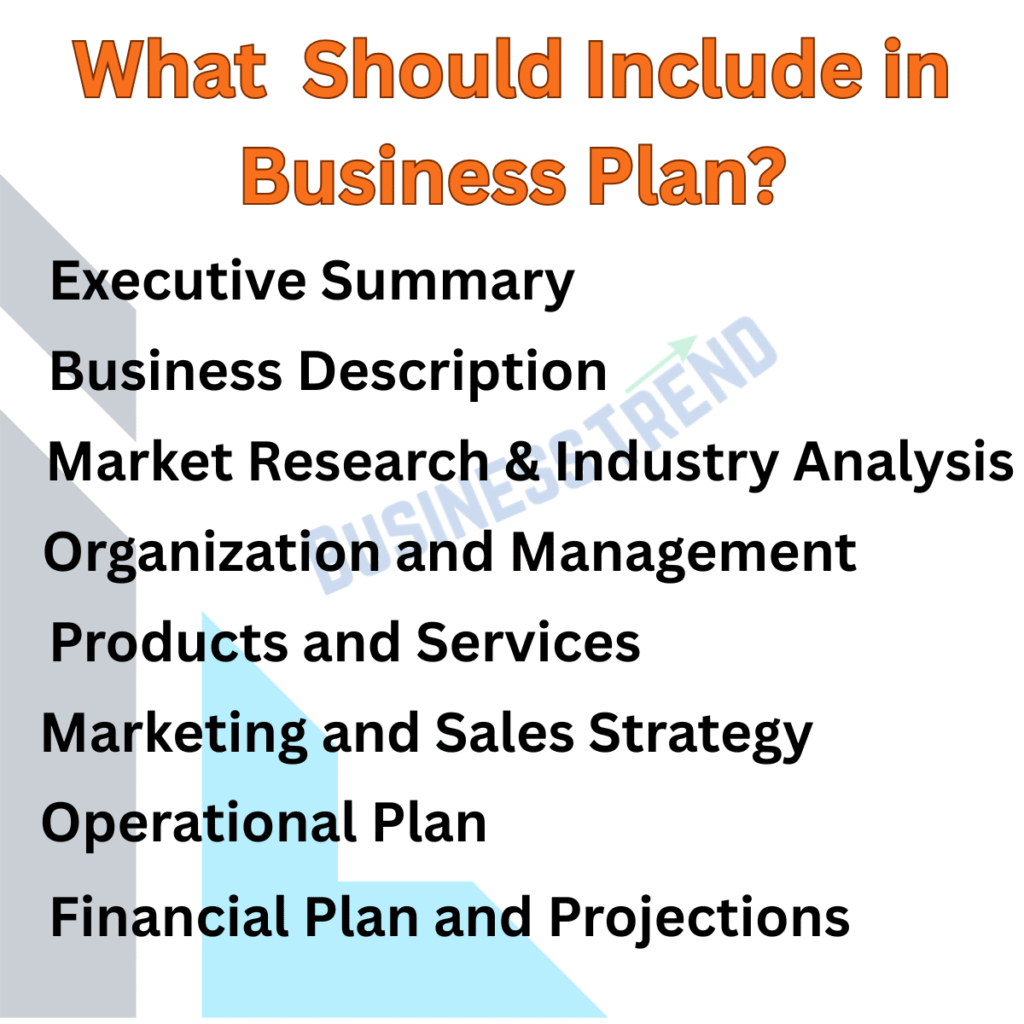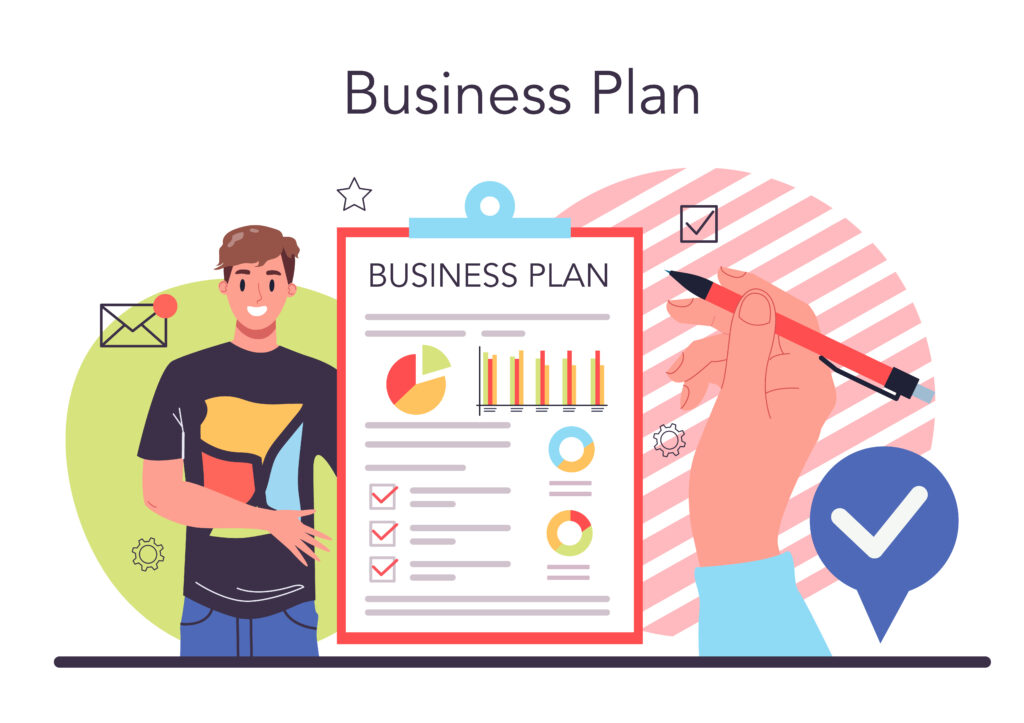Business startup is an exciting step but without planning it can be problematic. You need a clean and clear business plan to start any business. Business plan is just not a document, it’s the key to success.
A business plan helps you to identify your goals, strategies and possible outcomes. You can focus on your business through a business plan. It is one of the essential parts of your business whether you are starting a business or plan to grow your business.
Why is it so important?
Because it gives you direction. It shows investors, banks, or even partners that you know what you’re doing. A well-crafted business plan proves that you’ve done your homework.
It also helps you:
- Understand your market
- Identify your competition
- Plan your budget and forecast profits
- Set clear goals and milestones
It is just like a GPS. Without GPS you can’t move or reach your destination. GPS helps you to find the way and reach your destination. In the similar way, a business plan provides you a roadmap to achieve your goals.
No company in the world starts business without a plan. This plan could be simple, short or detailed. The big companies like Apple, Amazon, Airbnb and many others started with a proper vision and today they became giants.
In this article, we’ll provide you with complete detail to make a business plan step by step. For writing a business plan, you don’t need to be a business or finance expert. Follow the steps given below and start making a business plan.
Let’s get started.
What Should a Business Plan Include?
A business plan is not just a paper. It’s a roadmap that describes what to do and how to do. Your business plan tells you how you can succeed. It doesn’t matter, you are making a plan for yourself, investor or bank. You should have a clean and realistic business plan.

Let’s discuss what should be included in the business plan.
Executive Summary
Writing an executive summary is the first step, however it is written at last. It provides you with a quick overview of your plan. This section includes business ideas, target audience and the factors that make your business unique.
What to include:
- Business name and location
- What your business does
- Your mission and vision
- Key financial highlights
- Funding needs (if any)
Keep it short, clear, and persuasive. Think of it as your elevator pitch.
Business Description
This section provides more details about your company. Here, you have to add three things like what is your business, who are you serving and what problem can you solve.
You should cover:
- Industry background
- Legal structure (sole proprietorship, partnership, LLC, etc.)
- Business history (if already running)
- Core values and mission
Let readers understand why your business matters and how it stands out.
Market Research & Industry Analysis
This section shows that you understand your market and competition. It’s where you prove there’s real demand for your product or service.
Include details like:
- Who is your target audience?
- What are their needs, problems, and buying habits?
- Who are your main competitors?
- What are your competitive advantages?
To provide clear snapshot of your business, you can add SWOT analysis (Strengths, Weaknesses, Opportunities, Threats)
Organization and Management
In this section, you need to identify who will run and manage your business. Highlight your team members, if you have. Describe the role of each team member so that everyone is aware of his working.
Cover points like:
- Ownership structure
- Management team and their experience
- Organizational chart (if available)
- Roles and responsibilities
Even if it’s just you, list your skills and how you’ll manage all areas of the business.
Products and Services
Now it’s time to talk about what you sell. Describe your product or service in detail. Show why people will want it.
Add info such as:
- Description of your products or services
- The problem they solve
- What makes them unique
- Future product development plans
If possible, include pricing, production methods, or any patents and trademarks.
Marketing and Sales Strategy
In this section, you will decide how you will promote your business. Make a strategy to reach your customers and sell products or services.
Answer questions like:
- How will people know your business?
- What platforms or tools will you use (social media, SEO, email marketing, etc.)?
- What’s your pricing strategy?
- What does your sales funnel look like?
Simple and clear marketing plan helps you to get the attention of investors.
Operational Plan
Operational plan means how your business will work day by day. You have to set targets for each day and make a plan to execute them.
Include:
- Your location and facilities
- Equipment and technology needed
- Supply chain and vendors
- Inventory and fulfillment processes
This is where you turn your vision into practical steps.
If you don’t have finance and are looking for funding, then this section is very important for you.
Your financial plan should include:
- Profit and loss statement
- Cash flow statement
- Balance sheet
- Break-even analysis
- Funding requirements (if needed)
Add realistic numbers and back them with research. If you’re just starting, use estimates based on industry standards.
Types of Business Plans
There are hundreds of businesses in the world. Every business requires a specific business plan depending upon goals, customers and business format. Some businesses need a long and detailed plan while some need a short plan, even a single page plan.
Let’s discuss some business plans and when to use them.
Traditional Business Plan
This is the most common business plan format. A traditional business plan is perfect for most businesses especially for entrepreneurs who are looking for funding. This type of plan covers everything of your business from marketing to outcomes.
Use it when:
- You’re applying for a loan or investment
- You want to set long-term goals
- You need a comprehensive plan to follow
Pros:
- Very detailed and thorough
- Builds trust with investors and banks
Cons:
- Time-consuming to create
- Requires research and planning
Lean Startup Plan
A lean business plan is a short and focused plan. It is best for startups who test their business idea. This type of business plan is not more than a page. It includes basic things.
Use it when:
- You’re just starting out
- You want to test and adjust your idea fast
- You’re pitching your idea to partners or mentors
Pros:
- Easy to update
- Saves time
- Great for internal use
Cons:
- Lacks deep detail
- Not always suitable for investors
One-Page Business Plan
As the name suggests, this is a very short version of a business plan. It summarizes your business idea on a single page. It’s great for brainstorming or presenting a quick snapshot to someone who doesn’t have time to read a full plan.
What to include:
- Business name and vision
- Target market and customer problem
- Your solution
- Revenue model
- Marketing plan
- Key milestones
Use it when:
- You’re sharing a quick overview
- You want to keep things simple
Pros:
- Clear and concise
- Great for quick discussions
Cons:
- Not suitable for securing funding
- Lacks full strategic planning
Which One Should You Choose?
It depends on your goal.
- Looking for funding? Go with the traditional business plan.
- Trying out a new idea? The lean plan is faster and more flexible.
- Just want a quick summary? Use the one-page plan.
The good news? You can start small and build your plan over time. Many entrepreneurs begin with a lean or one-page version, then expand it as the business grows.
Step-by-Step Guide to Write a Business Plan
Writing a business plan might be difficult. However, if you follow the steps, it will be easy for you to write a comprehensive business plan. We have made steps to create a powerful business plan.

1. Start with a Clear Executive Summary
Your executive summary should be short but powerful. It’s the first thing readers see, so make it count.
What to include:
- Business name and location
- What your business does
- Mission and vision
- Brief overview of your product or service
- Target market
- Summary of financial highlights
- Your future goals
Tip: Write this last, after you’ve completed the rest of your plan.
2. Describe Your Business
In this section, explain the basics of your business. Keep it simple and informative.
Cover details like:
- Company name and type (e.g., LLC, partnership)
- Industry background
- Your story – why you started
- Business goals and objectives
- Core values and beliefs
This gives readers a clear picture of who you are and what you do.
3. Conduct Market Research
Before you sell anything, you need to know your audience. Market research proves that there’s demand for your business.
How to do it:
- Identify your target customers
- Study their needs and behaviors
- Analyze competitors
- Look at industry trends
- Use tools like Google Trends, Statista, or customer surveys
4. Outline Your Products or Services
This section is all about what you sell and why people want it.
Include:
- A simple description of your product or service
- Key features and benefits
- How it solves a problem
- Pricing strategy
- Future plans (new features or products)
Make it easy to understand—even for someone who’s never heard of your business.
5. Create a Marketing and Sales Plan
You’ve got a great product—now how will you sell it?
Cover these points:
- Marketing channels (social media, email, SEO, etc.)
- Advertising strategy (Google Ads, influencer marketing, etc.)
- Sales process (online, in-person, phone)
- Promotions and offers
- Customer relationship management
6. Define Your Business Operations
This part explains how you’ll run your business day to day.
Talk about:
- Business location and facilities
- Technology and equipment
- Inventory and supply chain
- Staff and human resources
- Delivery or service process
Even if you’re running a small business alone, explain how you’ll manage everything.
7. Build Your Management and Team Section
People invest in people. Introduce your team and show their value.
Include:
- Team members and their roles
- Experience and background
- Organizational structure (use a simple chart if needed)
- Advisory board or mentors (if any)
If you’re a solo founder, highlight your skills and how you’ll outsource or get help.
8. Prepare Your Financial Plan
This is a critical section—especially if you’re seeking funding.
You should include:
- Start-up costs and funding needs
- Income and expense projections
- Profit and loss statement
- Cash flow forecast
- Break-even analysis
Use charts and graphs to make the numbers easier to understand.
9. Add Supporting Documents (If Needed)
This isn’t mandatory for all business plans, but it can strengthen your presentation.
Examples:
- Licenses and permits
- Product images
- Legal documents
- Market research reports
- Letters of intent from customers or partners
We are sure that if you follow these steps, you will create a well organized and professional business plan.
Common Mistakes to Avoid When Writing a Business Plan
A poor business plan can destroy your business idea. Many beginners make the same mistake and lose time, money, or even the trust of investors.

Below are the most common business plan mistakes and how to avoid them.
1. Being Too Vague or Generic
Avoid vague statements like “We will dominate the market” or “Our product is the best.”
Why it’s a mistake:
- Investors and partners want clear, specific information.
- Generic content shows a lack of research and planning.
Fix it: Use data, facts, and specific strategies to support your ideas.
2. Ignoring the Competition
Many business owners think they have no competition—but that’s rarely true.
Why it’s a mistake:
- Every business has competitors, even if the product is unique.
- Not analyzing them shows you’re unprepared.
Fix it: Do competitor analysis and show how your business stands out.
3. Overestimating Revenue and Underestimating Costs
It’s easy to be overly optimistic when forecasting profits. But unrealistic numbers can damage your credibility.
Why it’s a mistake:
- Investors will spot unrealistic projections.
- Underestimating costs may lead to financial trouble.
Fix it: Base your financials on real data and research. Always plan for unexpected expenses.
4. Writing for Yourself, Not Your Audience
Your customers or audience have no concern with your business plan. You have to write a business plan for yourself. Write in a way that you can represent to your bank or investors.
Why it’s a mistake:
- They won’t understand industry jargon or assumptions.
- The tone might not suit professional readers.
Fix it: Write clearly. Use simple language. Focus on your reader’s point of view.
5. Skipping the Market Research
Market research is the backbone of a strong business plan. Without it, your ideas lack proof.
Why it’s a mistake:
- You can’t build a plan on guesses.
- You risk targeting the wrong audience.
Fix it: Use surveys, competitor data, and online tools to back up your assumptions.
6. Making It Too Long or Too Short
Both extremes can hurt your business plan.
- Too short: Lacks depth and planning.
- Too long: Readers may lose interest and skip important parts.
Fix it: Keep it clear and concise. Use headings, bullet points, and visuals to make it easy to skim.
7. Not Updating the Plan
A business plan demands updates with time. It is not a thing you make and forget. The customers, strategies and market trends change over the time. So, you have to update your business plan after different intervals of time.
Fix it: Review and update your plan regularly especially if you’re growing or shifting directions.
If you avoid these mistakes while writing a business plan, you can create a professional, creative and successful plan.
Tips to Make Your Business Plan Stand Out
A powerful business plan brings many opportunities for your business. In this section, we have brought expert tips that will help you. Whether you are planning for yourself, for a client, for a bank or for any investor, you can refine your business plan with these tips.
1. Start with a Powerful Executive Summary
Your executive summary is your first impression. Make it count.
Tip: Write a comprehensive summary that explains your business. What will you do and how will you get success?
2. Use Clear and Simple Language
Complicated words don’t impress—they confuse.
Tip: Write a plan in simple and easy language. It is better to write in your own language. Don’t use complex words. Write just like you’re explaining to your friend.
3. Back Up Your Claims with Data
Anyone can say “We’ll be successful.” But numbers tell a stronger story.
Tip: Use facts, stats, and real market research. Include charts, graphs, and references when possible. This builds credibility and shows you’ve done your homework.
4. Keep the Design Clean and Professional
Your business plan isn’t just about what you say—it’s also how it looks.
Tip: Use consistent formatting, fonts, headings, and spacing. Add visuals where needed. Consider using tools like Canva or templates from Google Docs or Microsoft Word.
5. Show Passion and Vision
Investors and partners don’t just invest in ideas—they invest in people.
Tip: Let your enthusiasm shine. Talk about why you started this business and what drives you. A personal touch can make your plan more memorable.
6. Be Honest About Risks and Challenges
No business is risk-free. Hiding challenges makes your plan look unrealistic.
Tip: Identify key risks and explain how you’ll manage them. This shows you’re aware and prepared.
7. Customize the Plan for Your Audience
Don’t use a one-size-fits-all approach.
Tip: If you’re pitching to a bank, focus on profitability and stability. If it’s for internal planning, highlight operational and team goals.
8. Include a Clear Call-to-Action
End your business plan with a purpose.
Tip: If you’re sending it to an investor, tell them what you want—funding, a meeting, or a partnership. Be clear about next steps.
Tools and Resources to Help You Write a Business Plan
There is no need to start from scratch. There are many free and paid tools available that can help you to make and improve business plan. These tools save your time and ensure you get a professional plan.
Below are the best tools and platforms to guide you through the process.
1. Business Plan Software & Generators
These tools offer templates, prompts, and automated formatting to make business plan writing easier.
Top Options:
- LivePlan – Paid tool with step-by-step guidance and financial forecasting features.
- Enloop – Automatically generates financials and scores your plan.
- Bizplan – Easy drag-and-drop builder with visual tools and investor presentation features.
- Upmetrics – Provides pre-made templates and real-time collaboration for teams.
2. Free Business Plan Templates
Templates are great if you prefer to work in Word, Google Docs, or Excel.
Where to find free templates:
- SBA.gov (Small Business Administration) – Offers free, downloadable business plan templates.
- Score.org – Provides sample business plans for various industries.
- Canva – Has visually designed business plan templates that are easy to edit.
- Microsoft Office or Google Docs – Search for “business plan” in their template gallery.
3. Market Research Tools
To strengthen your plan, you’ll need accurate data about your industry and competitors.
Recommended tools:
- Google Trends – Shows what’s trending in your industry.
- Statista – Offers global market and consumer data (free and paid).
- SEMrush / Ahrefs – Great for competitor analysis and SEO data.
- Ubersuggest – Helps with keyword research and traffic analysis.
- SurveyMonkey / Google Forms – Use them to collect direct feedback from your target audience.
4. Financial Planning Tools
These help you build your financial section with confidence.
Useful options:
- QuickBooks / FreshBooks – For tracking expenses and projecting future finances.
- Excel / Google Sheets – Use templates for profit & loss, cash flow, and break-even analysis.
- PlanGuru – Ideal for budgeting, forecasting, and financial analytics.
5. Writing and Editing Tools
To ensure your plan is error-free and professional, use these tools.
Helpful apps:
- Grammarly – Checks grammar, spelling, and clarity.
- Hemingway Editor – Improves readability and keeps your writing clear.
- Google Docs – Good for writing, collaboration, and auto-saving.
- Notion or Evernote – Perfect for organizing research, notes, and outlines.
Using these tools will not only save time but also improve the quality and structure of your business plan. Whether you’re just starting or refining your draft, these resources give you the edge.
FAQs About Writing a Business Plan
Want to know more about how to write a business plan? You can depend on others. Read on for common questions that new entrepreneurs, freelancers and small business owners usually ask.
Q1: In what format should a business plan be and how long should it be?
The page count in your business plan can vary from 15 to 30, depending on your business. This part of the cover letter should be brief but still include plenty of information. Ensure your information is clear and choose only what should be there. Extra data should be included in an appendix.
Q2: Can I operate my business without a business plan if I don’t require funding?
Yes! Creating a business plan, although you aren’t raising capital, provides you with goals, clear guidance and focus. It aids you in choosing the right path and following your progress. It acts as a guide for your business.
Q3: Should I update my business plan on a weekly, monthly or yearly basis?
At least yearly or when a key event like these takes place, you should go over and prepare your business plan to meet these changes.
Q4: What is the key focus of any business plan?
Whereas all parts get attention, most investors and banks give careful attention to the executive summary, the analysis of the market and the numbers projected for finances.
Q5: Is it possible to use AI in writing my business plan?
Yes. With the help of ChatGPT, people can brainstorm solutions, better write their tasks and make useful outlines. It’s also important to check the accuracy of your spreadsheet by inputting the data manually.
Q6: Should I hire someone to craft my business plan on my behalf?
Not necessarily. By using the proper resources (such as this guide), you have the ability to write your resume yourself. Yet, when you require a lot of investment or need your business to be outstanding, then turning to a business consultant or writer is a wise option.
Q7: If I create my business plan, what format is best for saving or sending it out?
A PDF is often how people save their documents. You won’t see any grime when you type and others can’t modify what you write. Should you be working with a group, work in Google Docs or Word and export the document to PDF once all changes are done.
Q8: Can a business plan assist me in designing my marketing strategy?
Absolutely. Being clear about marketing in your plan helps you choose your audience, create messages and decide on your budget. It lays the groundwork for the real marketing campaigns you will run.
Q9: What happens if I want to change the direction of my business over the years?
That’s normal. A business plan changes as your business experiences growth. When you update your plan, it demonstrates you are capable of adjusting to what’s happening in the market.


16 Comments
Pingback: How to Start an Online Business in 2025 -
Pingback: How to Start a Cleaning Business in 2025: 8 Easy Steps
Pingback: How to Start a Vending Machine Business: Cost, Tips, Location -
Pingback: How to Start a Roadside Assistance Business Without Towing -
Pingback: How to Start a Bookkeeping Business from Scratch in 2025 -
Pingback: How to Start a Detailing Business in 2025 -
Pingback: What is Dropshipping? Easy Explanation for Beginners
Pingback: What is a Business Plan? Importance, Benefits, and Free Generator to Create One Instantly - Vent Magazines
Pingback: Procurementnation.com Dropshipping Guide 2025
Pingback: How to Start a Heating and Air Conditioning Business? -
Pingback: Starting a Box Truck Business in 2025: Everything You Need to Know -
Pingback: Start a Boutique Business That Sells – A Beginner's Blueprint -
Pingback: Build Your Plumbing Business from Scratch and Get Clients Fast -
Pingback: How to Start a Junk Removal Business in 2025?
Pingback: Mobile Bar Business: A Profitable Idea You Can Start Today -
Pingback: How to Start Your Courier Business Journey Easily -